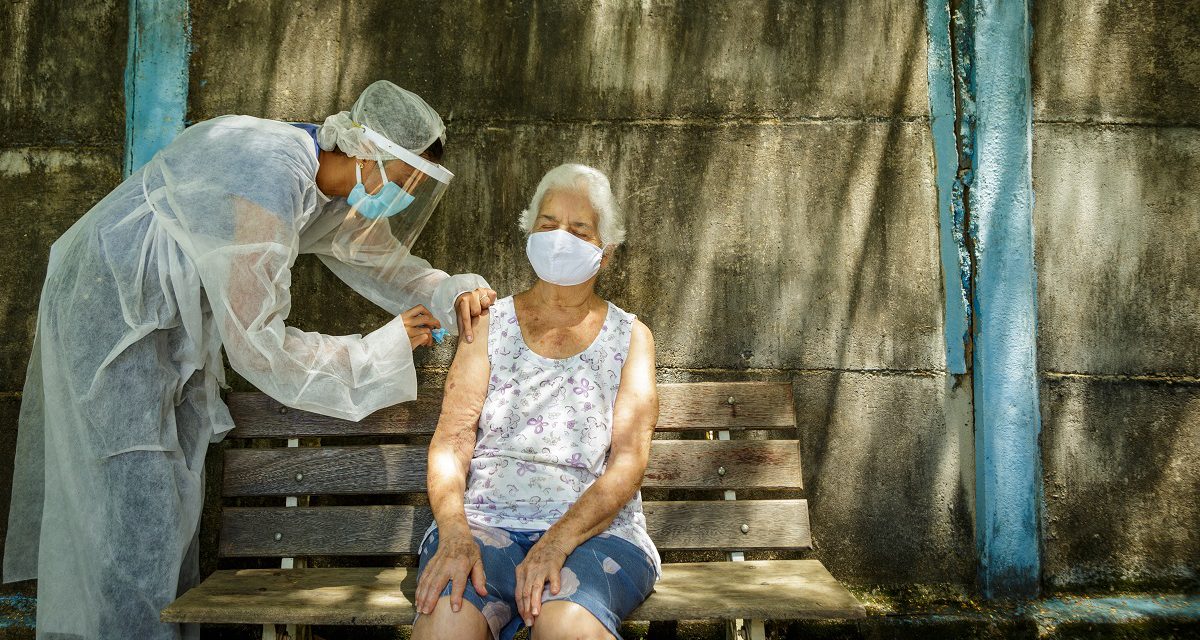More than 70 million Americans remain unvaccinated against COVID-19 as hospitals reach capacity and death tolls rise. The Delta variant is slated to be more than two times as infectious as previous strains, with a viral load (a measure of the density of viral particles in the body) of at least 1000 times higher than other variants, according to some reports. The Centers for Disease Control and Prevention (CDC) described Delta as more transmissible than the common cold and flu – as well as the viruses that cause smallpox, MERS, SARS, and Ebola – and called it as contagious as chickenpox. This determination comes from a CDC internal document obtained by and reported on in a recent New York Times article.
If that’s not enough, the young and unvaccinated are among the patients landing in hospital ICUs – many of whom are in their 20s and 30s. According to a recent NPR article, 94,000 child cases of COVID-19 were reported in early August, a 31% increase compared with just one week earlier.
Hope deferred
These optics are far different than early 2020, when most severely ill COVID-19 patients in ICU beds were older adults. During the recent Get Link’d 2021 Missouri Rural Health Association Conference, Richard Logan, Pharm. D. – ESPhA, talked about COVID-19 vaccine efforts in Southeast Missouri – an area that is flagrantly vaccine hesitant. Dr. Logan, along with his son Tripp, own and operate three independent pharmacies in Mississippi County, which sits on the far Southeast corner of Missouri.
Charleston, Missouri is Dr. Logan’s lifelong home. It’s also where his L&S Pharmacy is headquartered, and is 20 miles from the closest hospital. Charleston and neighboring East Prairie are the only two cities in the county with clinics, pharmacies, and the county health department.
“Like most of rural Missouri, this area of the state is highly agricultural. The demographics include some of the poorest in the state,” he said. “We have the poorest folks, with the poorest health literacy. We say we are ‘the land of fried chicken, fried catfish, and sweet tea.’”
When the pandemic first took shape in the U.S., Dr. Logan recalled how it hit both coasts as ICU beds filled. “From the safety of rural Missouri, we watched mobile hospitals begin to popup, and we watched people get sicker and sicker and sicker from COVID-19… We watched hospitals on both coasts call in refrigerated trucks to act as makeshift morgues.”
The pandemic eventually made its way to middle America, hitting St. Louis, Kansas City and Springfield, Missouri. “And then we began to see the trickle of patients at our local hospital in Scott County and in Sikeston reach capacity,” Dr. Logan said. “We realized it was here; it was among us, and we had to do something.”
Pharmacies closed their lobbies and went to curbside service, and physicians’ offices transitioned from office visits to telehealth. Realizing this meant patients would fall through the cracks, Dr. Logan and his team of community health workers (CHWs) launched outreach efforts to find out who needed medication, and who needed access to a physician.
He also brought potentially infected individuals to the pharmacy and performed rapid COVID testing. This hit home, literally. “My wife and I were driving, and she said to me, ‘What if you get this virus, and what if you bring it home to me?’” At the time, the Logans had lost two childhood friends to the virus. “I said to her, I signed up for this. This is what I do, and this is what I’m going to do, but you didn’t sign up for this.” After offering to move into their rental house to mitigate exposure, his wife said, “No, we’re in this together and we’ll beat this thing together.”
That conversation prompted Dr. Logan to add sneeze guards in his pharmacy lobbies so they could reopen and provide services for patients with COVID and other diseases.
Then, news came that at least one vaccine was granted emergency use authorization by the FDA. Logan said he envisioned the federal government coming into town and running a communitywide vaccination program, much like how the polio vaccines were handled. Eventually, it became clear that the government was going to distribute the vaccine, not shots. And the places that had the infrastructure for mass vaccination clinics would not reach all of the population, particularly his patients – the members of his community, those he cared for and cared about.
On top of that, pharmacists faced many regulations which stifled progress. They could only vaccinate within their own walls and where they had a collaborative practice agreement.
When two or more come together
The state of Missouri soon stepped in and asked about the barriers that circumvented vaccine delivery. Dr. Logan said there was no vaccine to deliver, and second, regulatory barriers confined them from vaccinating individuals beyond pharmacy walls. The state opted to relax the regulations to get shots in as many arms as possible.
“We had no plan,” Dr. Logan said. “None of us had ever been through this before. We knew as a pharmacy we didn’t have the personnel to do it. We also knew the health department, which was absolutely slammed at the time, did not have the bandwidth to provide vaccines to a whole county. None of us in the earlier stages received enough vaccine to make a sizable dent in the county’s population of about 14,000.”
But what they did have was four independent pharmacy owners who got along, were longtime friends, and who faced a common goal: taking care of the county’s people. This birthed a cooperative that met, strategized, and pooled resources, including using vaccine supply from each entity. The county commissioner, who also happened to be one of Dr. Logan’s longtime friends, chimed in and asked what they needed and how the county could help. Ultimately, they provided support with clinic setups, parking, and volunteer recruitment, among other things.
The cooperative created a workflow design that facilitated a large-scale vaccination clinic and purchased a subscription to an online scheduling platform that they all could access, including the health department.
From there, they streamlined the process to make sure individuals wanting the vaccine could call, make appointments, and receive appointment reminders. They picked vaccination venues that were the best fit for scale and access. When it was all said and done, Mississippi County was the third most vaccinated county behind Cape County (which houses two large health systems) and Scott County.
In an early August New York Times article, Mississippi County had a 64% vaccination rate for individuals 65 years and older, and overall, the county’s vaccination rate was about 32%. “It was a testament to our efforts and our follow through,” Dr. Logan said. “I don’t think you can safely claim success in any of these clinics if you give the first shot and it’s not followed in due course by the second shot. We found this required follow up with individual patients.”
Pleased with the outcome and volume, Dr. Logan said some clinics vaccinated 200 people in a day, while others vaccinated 700 people.
Then the other shoe dropped. “The plan worked well until it didn’t,” he said.
Toward the end, attendees to vaccinations decreased drastically. Dr. Logan said they realized they were dealing with three groups: the ones who were anxious to get vaccinated; the wait and see group; and the “no-chance” group.
“All of the entities involved realized that our mass clinics had served their purpose,” he said, “and we had done about all we could do there. But we also knew that we had to make sure that vaccine was still available as groups two and three began to change their minds and come online.”
Working in tandem once again, the cooperative developed a staggered approach to getting shots in arms. Individually they continued public education and outreach efforts to reach the hesitant, while bringing vaccinations in-house with staggered days and hours so that anyone who wanted a vaccine could get one.
Fighting the good fight
As mass vaccination clinics fizzled, and as children as young as 12 years old became eligible for the vaccine, Dr. Logan and his team of CHWs redoubled public outreach efforts. This often meant using a more personal approach to give the shot. They vaccinated people at civic events, dance recitals, and popup clinics, and made weekly house calls to homebound individuals. Dr. Logan and his team even ended up on the pulpit one Sunday morning.
“I will have to say, I tend to preach a sermon like a Baptist preacher at a tent revival,” he said. “I tried to call down the lightning on them; it was such a wonderful experience.” Eleven children were vaccinated at the church that Sunday. Since then, Dr. Logan’s Sunday schedule has remained busy.
As the Delta variant continues to claim more victims, Dr. Logan, his team, and the other players in Mississippi County have gathered their second wind to continue the race while the uptick in vaccinations takes place. It’s expected, he said, that the new recommendations from the CDC for booster shots will help maintain increased vaccinations. Dr. Logan encourages those on the frontlines working to get as many shots in arms as possible not to lose heart.
“Don’t give up,” he said. “I was sitting at a popup clinic booth and this man walked by and I asked if he’d had his COVID shot. ‘Would you like one?’ I asked. He turned to me and said, ‘That is the devil’s medicine, and you are the devil for delivering it.’ And he was dead serious. I think the takeaway is don’t get disheartened by things like that. At some point, I am going to get that guy, and we are going to vaccinate him.”
(A few days after the Conference concluded, the U.S. Food and Drug Administration approved what has been known as the Pfizer-BioNTech COVID-19 Vaccine. It will now be marketed as Comirnaty, approved for individuals 16 years and older. The vaccine remains under emergency use authorization for children 12 to 15 years old, and as a booster, or a third dose, for some individuals who are immunocompromised. Additionally, a recent executive order now requires COVID-19 vaccinations for federal employees.)








